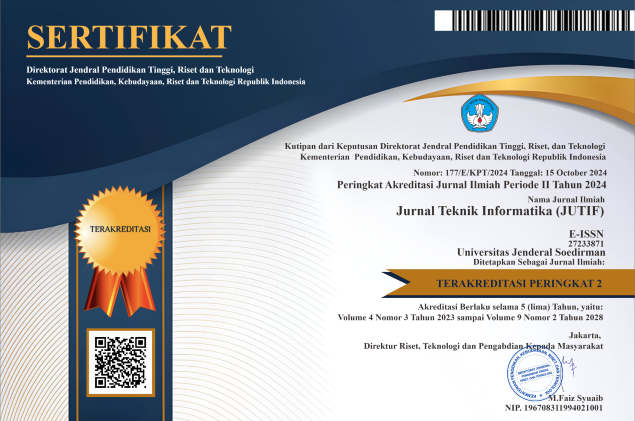A Hybrid LSTM–Smith Waterman Model for Personalized Semantic Search in Academic Information Systems
DOI:
https://doi.org/10.52436/1.jutif.2025.6.4.4763Keywords:
Academic Information Systems, Learning Recommendation, Long Short-Term Memory, Semantic Matching, Smith WatermanAbstract
The growing complexity of digital learning environments presents a critical challenge in computer science, particularly in designing intelligent academic systems capable of delivering context-aware and personalized content. Traditional academic information systems often rely on literal keyword matching, failing to interpret the semantic intent behind user queries and ignoring historical learning behavior. This study addresses these limitations by proposing a hybrid semantic search and recommendation model that integrates Long Short-Term Memory (LSTM) networks with the Smith Waterman algorithm. The LSTM component models temporal sequences of user interactions, while Smith Waterman enables local semantic alignment between user queries and learning content. Historical query logs and user-clicked topics are transformed into semantic vectors, which are further enhanced through a contextual graph and semantic relation matrix. Experimental results demonstrate the model’s effectiveness, achieving 89% accuracy, an F1-score of 0.89, and an AUROC of 0.88 by epoch 50. The hybrid architecture successfully captures the evolution of user interest and semantic relevance, outperforming baseline approaches. This research contributes to the field of computer science by bridging natural language understanding and sequential modeling to improve adaptive learning technologies. The proposed model offers a scalable foundation for developing intelligent recommendation systems in academic platforms, fostering improved learner engagement and efficiency.
Downloads
References
M. Liu and D. Yu, “Towards intelligent E-learning systems,” Educ Inf Technol (Dordr), vol. 28, no. 7, pp. 7845–7876, Jul. 2023, doi: 10.1007/s10639-022-11479-6.
F. Fui-Hoon Nah, R. Zheng, J. Cai, K. Siau, and L. Chen, “Generative AI and ChatGPT: Applications, challenges, and AI-human collaboration,” Journal of Information Technology Case and Application Research, vol. 25, no. 3, pp. 277–304, Jul. 2023, doi: 10.1080/15228053.2023.2233814.
M. A. Almaiah, A. Al-Khasawneh, and A. Althunibat, “Exploring the critical challenges and factors influencing the E-learning system usage during COVID-19 pandemic,” Educ Inf Technol (Dordr), vol. 25, no. 6, pp. 5261–5280, Nov. 2020, doi: 10.1007/s10639-020-10219-y.
M. Gusenbauer and N. R. Haddaway, “What every researcher should know about searching – clarified concepts, search advice, and an agenda to improve finding in academia,” Res Synth Methods, vol. 12, no. 2, pp. 136–147, Mar. 2021, doi: 10.1002/jrsm.1457.
M. K. Mohammadi, A. A. Mohibbi, and M. H. Hedayati, “Investigating the challenges and factors influencing the use of the learning management system during the Covid-19 pandemic in Afghanistan,” Educ Inf Technol (Dordr), vol. 26, no. 5, pp. 5165–5198, Sep. 2021, doi: 10.1007/s10639-021-10517-z.
P. Ingavélez-Guerra, S. Otón-Tortosa, J. Hilera-González, and M. Sánchez-Gordón, “The use of accessibility metadata in e-learning environments: a systematic literature review,” Univers Access Inf Soc, vol. 22, no. 2, pp. 445–461, Jun. 2023, doi: 10.1007/s10209-021-00851-x.
A. Agarwal, D. S. Mishra, and S. V. Kolekar, “Knowledge-based recommendation system using semantic web rules based on Learning styles for MOOCs,” Cogent Eng, vol. 9, no. 1, Dec. 2022, doi: 10.1080/23311916.2021.2022568.
I. Gligorea, M. Cioca, R. Oancea, A.-T. Gorski, H. Gorski, and P. Tudorache, “Adaptive Learning Using Artificial Intelligence in e-Learning: A Literature Review,” Educ Sci (Basel), vol. 13, no. 12, p. 1216, Dec. 2023, doi: 10.3390/educsci13121216.
P. Bedi, S. B. Goyal, A. S. Rajawat, R. N. Shaw, and A. Ghosh, “A Framework for Personalizing Atypical Web Search Sessions with Concept-Based User Profiles Using Selective Machine Learning Techniques,” 2022, pp. 279–291. doi: 10.1007/978-981-16-2164-2_23.
A. Breit et al., “Combining Machine Learning and Semantic Web: A Systematic Mapping Study,” ACM Comput Surv, vol. 55, no. 14s, pp. 1–41, Dec. 2023, doi: 10.1145/3586163.
N. S. Raj and V. G. Renumol, “A systematic literature review on adaptive content recommenders in personalized learning environments from 2015 to 2020,” Journal of Computers in Education, vol. 9, no. 1, pp. 113–148, Mar. 2022, doi: 10.1007/s40692-021-00199-4.
V. Setlur, A. Kanyuka, and A. Srinivasan, “Olio: A Semantic Search Interface for Data Repositories,” in Proceedings of the 36th Annual ACM Symposium on User Interface Software and Technology, New York, NY, USA: ACM, Oct. 2023, pp. 1–16. doi: 10.1145/3586183.3606806.
S. M. R. Naqvi, M. Ghufran, C. Varnier, J.-M. Nicod, K. Javed, and N. Zerhouni, “Unlocking maintenance insights in industrial text through semantic search,” Comput Ind, vol. 157–158, p. 104083, May 2024, doi: 10.1016/j.compind.2024.104083.
M. Ovando-Tellez et al., “An investigation of the cognitive and neural correlates of semantic memory search related to creative ability,” Commun Biol, vol. 5, no. 1, p. 604, Jun. 2022, doi: 10.1038/s42003-022-03547-x.
A. Sharma and S. Kumar, “Ontology-based semantic retrieval of documents using Word2vec model,” Data Knowl Eng, vol. 144, p. 102110, Mar. 2023, doi: 10.1016/j.datak.2022.102110.
P. N. Andono, Sunardi, R. A. Nugroho, and B. Harjo, “Aspect-Based Sentiment Analysis for Hotel Review Using LDA, Semantic Similarity, and BERT,” International Journal of Intelligent Engineering and Systems, vol. 15, no. 5, pp. 232–243, Oct. 2022, doi: 10.22266/ijies2022.1031.21.
M. Muljono, B. Harjo, and R. Abdullah, “Aspect-Based Sentiment Analysis for Financial Review with Implicit Aspect and Opinion Using Semantic Similarity and Hybrid Approach,” International Journal of Intelligent Engineering and Systems, vol. 17, no. 5, pp. 646–658, Oct. 2024, doi: 10.22266/ijies2024.1031.49.
D. Sheth and M. Shah, “Predicting stock market using machine learning: best and accurate way to know future stock prices,” International Journal of System Assurance Engineering and Management, vol. 14, no. 1, pp. 1–18, Feb. 2023, doi: 10.1007/s13198-022-01811-1.
T. Sommerschield et al., “Machine Learning for Ancient Languages: A Survey,” Computational Linguistics, pp. 1–44, May 2023, doi: 10.1162/coli_a_00481.
S. Ciampelli, A. E. Voppel, J. N. de Boer, S. Koops, and I. E. C. Sommer, “Combining automatic speech recognition with semantic natural language processing in schizophrenia,” Psychiatry Res, vol. 325, p. 115252, Jul. 2023, doi: 10.1016/j.psychres.2023.115252.
T. Berners-Lee, J. Hendler, and O. Lassila, “The Semantic Web: A New Form of Web Content that is Meaningful to Computers will Unleash a Revolution of New Possibilities,” in Linking the World’s Information, New York, NY, USA: ACM, 2023, pp. 91–103. doi: 10.1145/3591366.3591376.
L. Tamine and L. Goeuriot, “Semantic Information Retrieval on Medical Texts,” ACM Comput Surv, vol. 54, no. 7, pp. 1–38, Sep. 2022, doi: 10.1145/3462476.
N. Yang, J. Jo, M. Jeon, W. Kim, and J. Kang, “Semantic and explainable research-related recommendation system based on semi-supervised methodology using BERT and LDA models,” Expert Syst Appl, vol. 190, p. 116209, Mar. 2022, doi: 10.1016/j.eswa.2021.116209.
M. Paneque, M. del M. Roldán-García, and J. García-Nieto, “e-LION: Data integration semantic model to enhance predictive analytics in e-Learning,” Expert Syst Appl, vol. 213, p. 118892, Mar. 2023, doi: 10.1016/j.eswa.2022.118892.
H. Ezaldeen, S. K. Bisoy, R. Misra, and R. Alatrash, “Semantics aware intelligent framework for content-based e-learning recommendation,” Natural Language Processing Journal, vol. 3, no. 3, p. 100008, Jun. 2023, doi: 10.1016/j.nlp.2023.100008.
Y. Zhao, H. Liu, and H. Duan, “Semantic and relation aware neural network model for bi-class multi-relational heterogeneous graphs,” iScience, vol. 28, no. 4, p. 112155, Apr. 2025, doi: 10.1016/j.isci.2025.112155.
J. Li, J. Wang, H. Lv, Z. Zhang, and Z. Wang, “IMCHGAN: Inductive Matrix Completion With Heterogeneous Graph Attention Networks for Drug-Target Interactions Prediction,” IEEE/ACM Trans Comput Biol Bioinform, vol. 19, no. 2, pp. 655–665, Mar. 2022, doi: 10.1109/TCBB.2021.3088614.
Z. Xia et al., “A Review of Parallel Implementations for the Smith–Waterman Algorithm,” Interdiscip Sci, vol. 14, no. 1, pp. 1–14, Mar. 2022, doi: 10.1007/s12539-021-00473-0.
F. F. de Oliveira, L. A. Dias, and M. A. C. Fernandes, “Proposal of Smith-Waterman algorithm on FPGA to accelerate the forward and backtracking steps,” PLoS One, vol. 17, no. 6, p. e0254736, Jun. 2022, doi: 10.1371/journal.pone.0254736.
L. Li, J. Lin, and Z. Wang, “PipeBSW: A Two-Stage Pipeline Structure for Banded Smith-Waterman Algorithm on FPGA,” in 2021 IEEE Computer Society Annual Symposium on VLSI (ISVLSI), IEEE, Jul. 2021, pp. 182–187. doi: 10.1109/ISVLSI51109.2021.00042.
M. Abdullah, M. Ahmad, and D. Han, “Facial Expression Recognition in Videos: An CNN-LSTM based Model for Video Classification,” in 2020 International Conference on Electronics, Information, and Communication, ICEIC 2020, Institute of Electrical and Electronics Engineers Inc., Jan. 2020. doi: 10.1109/ICEIC49074.2020.9051332.
S. Rajan, P. Chenniappan, S. Devaraj, and N. Madian, “Novel deep learning model for facial expression recognition based on maximum boosted CNN and LSTM,” IET Image Process, vol. 14, no. 7, pp. 1227–1232, May 2020, doi: 10.1049/iet-ipr.2019.1188.
N. R. D. Cahyo, C. A. Sari, E. H. Rachmawanto, C. Jatmoko, R. R. A. Al-Jawry, and M. A. Alkhafaji, “A Comparison of Multi Class Support Vector Machine vs Deep Convolutional Neural Network for Brain Tumor Classification,” in 2023 International Seminar on Application for Technology of Information and Communication (iSemantic), IEEE, Sep. 2023, pp. 358–363. doi: 10.1109/iSemantic59612.2023.10295336.
M. M. I. Al-Ghiffary, C. A. Sari, E. H. Rachmawanto, N. M. Yacoob, N. R. D. Cahyo, and R. R. Ali, “Milkfish Freshness Classification Using Convolutional Neural Networks Based on Resnet50 Architecture,” Advance Sustainable Science Engineering and Technology, vol. 5, no. 3, p. 0230304, Oct. 2023, doi: 10.26877/asset.v5i3.17017.
Additional Files
Published
How to Cite
Issue
Section
License
Copyright (c) 2025 Ade Yuliana, Novita Lestari Anggreini, Rachmat Iskandar, G. Rafi Prasanth

This work is licensed under a Creative Commons Attribution 4.0 International License.



























